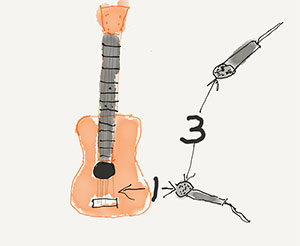It is easy to get away with recording imperfections nowadays, with all the technology available that helps ease the damages done by small mistakes. For example, an instrument out of tune can be filtered by a software called Melodyne and limit damages to your overall output. But does this mean that we go away with the simple task of tuning our instruments? Definitely no! Although these software’s were created to assist us in recordings it doesn’t mean that we go away our checks. Dealing with things from the start is better than having to patch up things in the end
Read more here: http://en.audiofanzine.com/recording-mixing/editorial/articles/the-importance-of-good-tuning.html
Music Recording
How To Record Hardware Synthesizers
Hardware synthesizers usually don’t come with an AD converter, be it analog or digital making recording quite a peculiar process. Your first problem lies in that you need to get the signal into your DAW, and that would be through your soundcard.
Here are two ways you can send a signal into your DAW using your soundcard so that you can go on with your recording.
First is a quite complicated method, here is how it is done. You need to send the signal into a bass or guitar amp before recording by placing a mic maybe more than one in front of the amp.
Read more here: http://en.audiofanzine.com/recording-mixing/editorial/articles/recording-a-hardware-synth.html
The NO-NO Of Recording
In any field, we could say that the basic foundation is always important. Like dribbling is a crucial fundamental skill to basketball and we could give so much more examples. But these basic skills is what brings out greatness in every craft.
Now in recording, there is one major No-no that you need to know. A lot of things could go wrong in a recording session that could be your fault or not, like a loose microphone stand that could lead the mic pointing in a totally different direction but it could be fixed.
Clipping though could literally alter your session and here is what you need to know about it.
Find out more here: http://www.homestudiocorner.com/the-number-one-no-no-of-recording/
Recording 101: The 3:1 Rule
 The 3:1 rule is oft-quoted, but it’s also a bit misunderstood. The rule is based upon the use of multiple microphones recording multiple (usually) instruments, and recording everything at the same time. There is quite a lot of misinformation about the 3:1 rule.
The 3:1 rule is oft-quoted, but it’s also a bit misunderstood. The rule is based upon the use of multiple microphones recording multiple (usually) instruments, and recording everything at the same time. There is quite a lot of misinformation about the 3:1 rule.
When you record with 2 or more microphones at the same time – especially if the microphones are not recording to separate tracks – you run a risk of the signals from the multiple mics not playing well with the other(s).
The whole reason for the 3:1 rule is to make sure the waveforms of multiple microphones don’t fight each other in the mix. When you use multiple mics, the signals bleed into all the mics and can cause what’s called “phase” problems where waves simultaneously cancel each other out or make certain frequencies louder. This creates a hollow, unpleasant sound (called “comb-filtering”). So proper spacing of mics via the 3:1 rule can help prevent this phasing in the mix.
Most folks recording at home these days record one thing at a time with usually only one mic on each thing. If you’re doing that (I do it like this mainly because I record everything myself:)), recording one thing at a time, the rule doesn’t come into play.
It also does not come into play when recording a single instrument in stereo – using 2 mics on one guitar, for example. This is a COMMON MISCONCEPTION.
What is the 3:1 Rule then?
This rule simply states that distance matters – the proper spacing from the instruments to your microphone or microphones. The distance between, say, mic A and mic B (if using 2 mics) should be at least 3 times the distance from mic A and the source (guitar, drums, etc.).
Find out more here: http://en.audiofanzine.com/recording-mixing/editorial/articles/the-3-1-rule.html
How To Record A Bowed Upright Bass
A member of the string family, the upright bass, also known as the double bass is the lowest pitched string instrument going as low as B0 (31Hz) on its five string version.
Recording this instrument can be quite tricky because of its low tone, you begin by choosing the right microphone. Choose a mic that can capture these frequencies.
Once you have picked the right mic you need to understand its vibration points since it is capable of producing vibrations mainly transmitted by its bridge. Knowing these details, you can now place your chosen mic in the right position.
Read more here: http://en.audiofanzine.com/recording-mixing/editorial/articles/recording-a-bowed-upright-bass.html